Comprehensive Report: Low Population Density and Growth in Australia
VerifiedAdded on 2020/07/22
|9
|1605
|143
Report
AI Summary
This report critically reviews articles on Australia's low population density and growth rate, examining various perspectives and their implications. The study explores factors such as geographical constraints, resource consumption, and household expenditure trends. It analyzes articles discussing population dynamics in regional Australia, consumption of natural resources, and household spending patterns. The report identifies the dominant purposes of the reviewed articles, which include analyzing population changes, consumption patterns, and economic impacts. The conclusion highlights that while Australia is a wealthy nation, its low population density and growth rate, influenced by factors like the large sea surface area, present unique challenges. It emphasizes the need for improved resource management strategies to support national growth and development. The report references several sources to support its analysis.
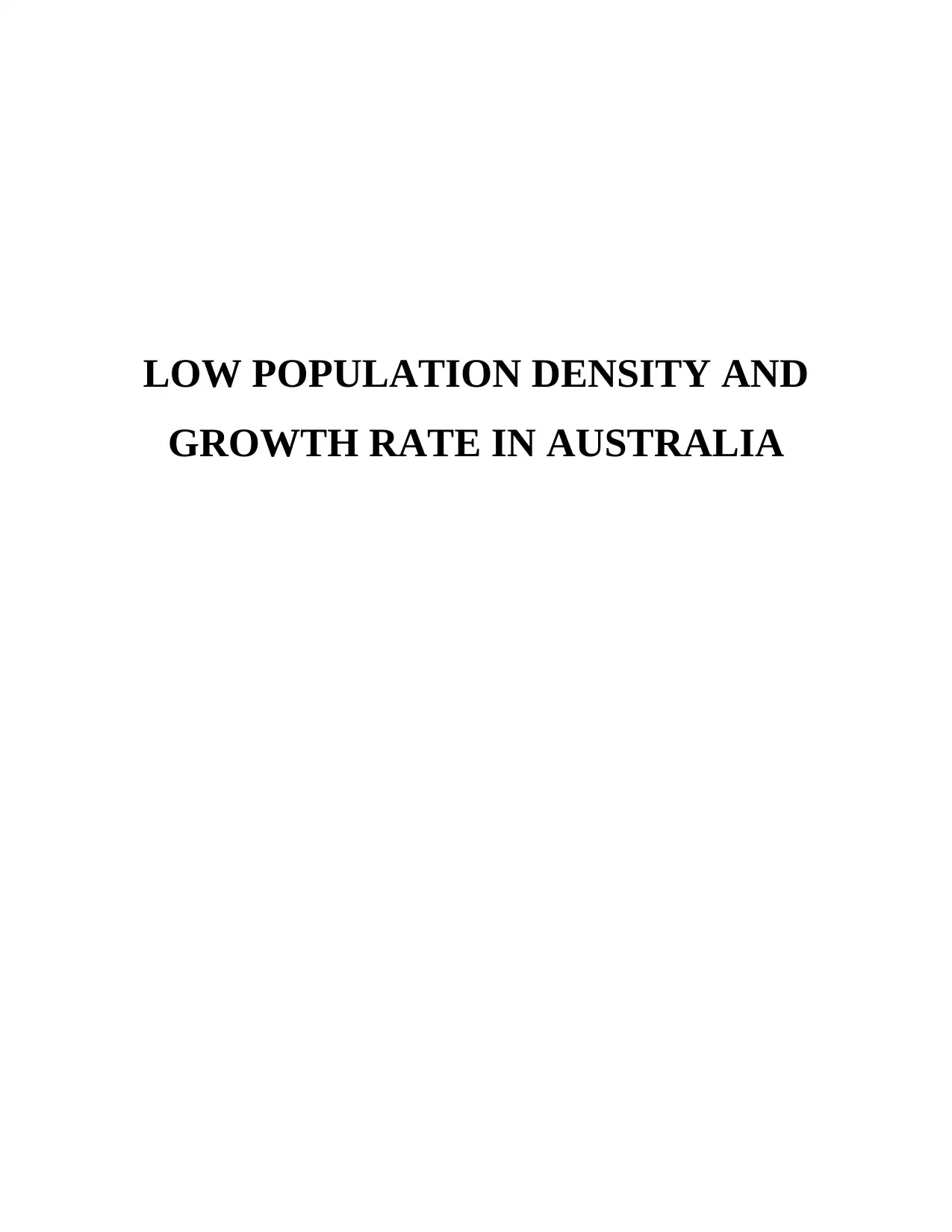
LOW POPULATION DENSITY AND
GROWTH RATE IN AUSTRALIA
GROWTH RATE IN AUSTRALIA
Paraphrase This Document
Need a fresh take? Get an instant paraphrase of this document with our AI Paraphraser
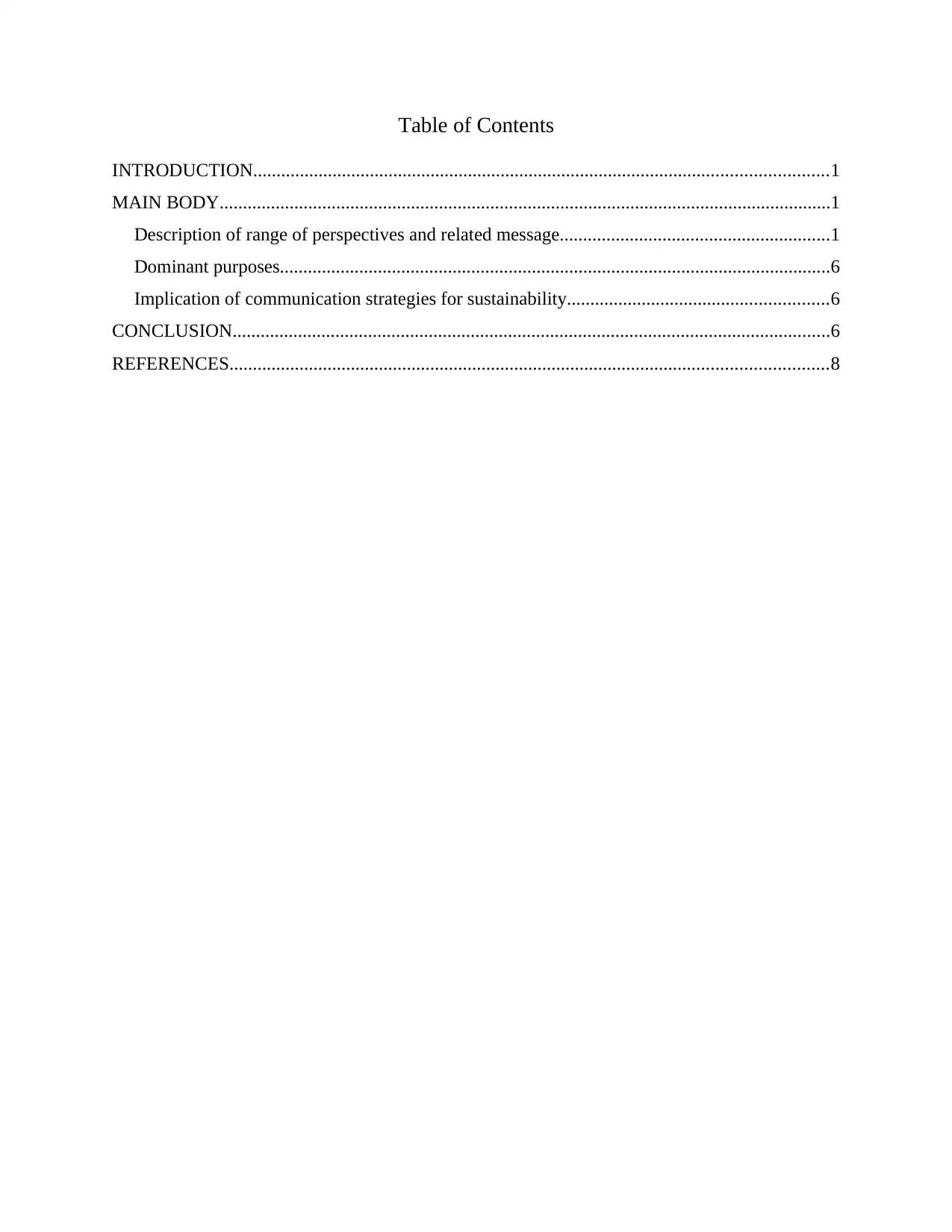
Table of Contents
INTRODUCTION...........................................................................................................................1
MAIN BODY...................................................................................................................................1
Description of range of perspectives and related message..........................................................1
Dominant purposes......................................................................................................................6
Implication of communication strategies for sustainability........................................................6
CONCLUSION................................................................................................................................6
REFERENCES................................................................................................................................8
INTRODUCTION...........................................................................................................................1
MAIN BODY...................................................................................................................................1
Description of range of perspectives and related message..........................................................1
Dominant purposes......................................................................................................................6
Implication of communication strategies for sustainability........................................................6
CONCLUSION................................................................................................................................6
REFERENCES................................................................................................................................8
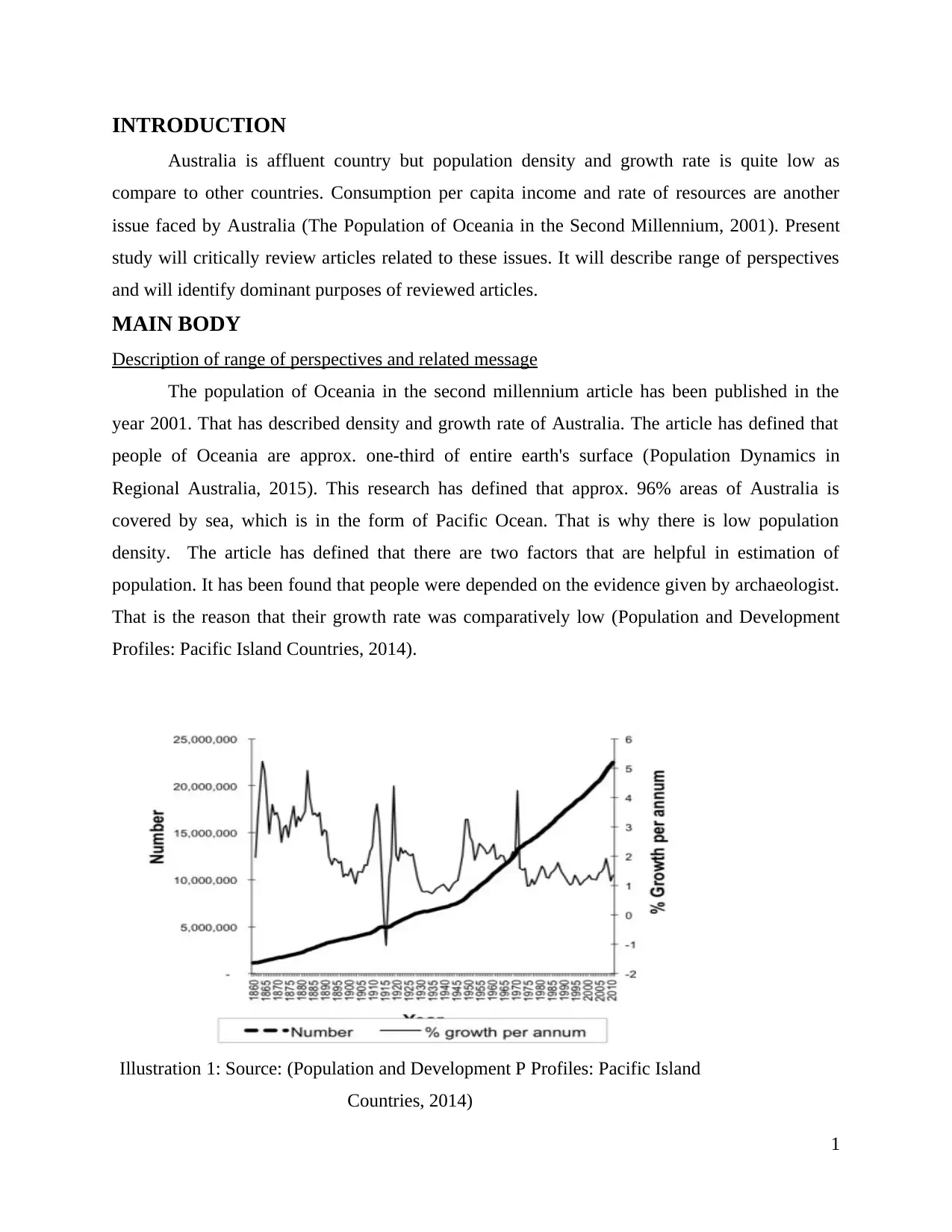
INTRODUCTION
Australia is affluent country but population density and growth rate is quite low as
compare to other countries. Consumption per capita income and rate of resources are another
issue faced by Australia (The Population of Oceania in the Second Millennium, 2001). Present
study will critically review articles related to these issues. It will describe range of perspectives
and will identify dominant purposes of reviewed articles.
MAIN BODY
Description of range of perspectives and related message
The population of Oceania in the second millennium article has been published in the
year 2001. That has described density and growth rate of Australia. The article has defined that
people of Oceania are approx. one-third of entire earth's surface (Population Dynamics in
Regional Australia, 2015). This research has defined that approx. 96% areas of Australia is
covered by sea, which is in the form of Pacific Ocean. That is why there is low population
density. The article has defined that there are two factors that are helpful in estimation of
population. It has been found that people were depended on the evidence given by archaeologist.
That is the reason that their growth rate was comparatively low (Population and Development
Profiles: Pacific Island Countries, 2014).
Illustration 1: Source: (Population and Development P Profiles: Pacific Island
Countries, 2014)
1
Australia is affluent country but population density and growth rate is quite low as
compare to other countries. Consumption per capita income and rate of resources are another
issue faced by Australia (The Population of Oceania in the Second Millennium, 2001). Present
study will critically review articles related to these issues. It will describe range of perspectives
and will identify dominant purposes of reviewed articles.
MAIN BODY
Description of range of perspectives and related message
The population of Oceania in the second millennium article has been published in the
year 2001. That has described density and growth rate of Australia. The article has defined that
people of Oceania are approx. one-third of entire earth's surface (Population Dynamics in
Regional Australia, 2015). This research has defined that approx. 96% areas of Australia is
covered by sea, which is in the form of Pacific Ocean. That is why there is low population
density. The article has defined that there are two factors that are helpful in estimation of
population. It has been found that people were depended on the evidence given by archaeologist.
That is the reason that their growth rate was comparatively low (Population and Development
Profiles: Pacific Island Countries, 2014).
Illustration 1: Source: (Population and Development P Profiles: Pacific Island
Countries, 2014)
1
⊘ This is a preview!⊘
Do you want full access?
Subscribe today to unlock all pages.

Trusted by 1+ million students worldwide
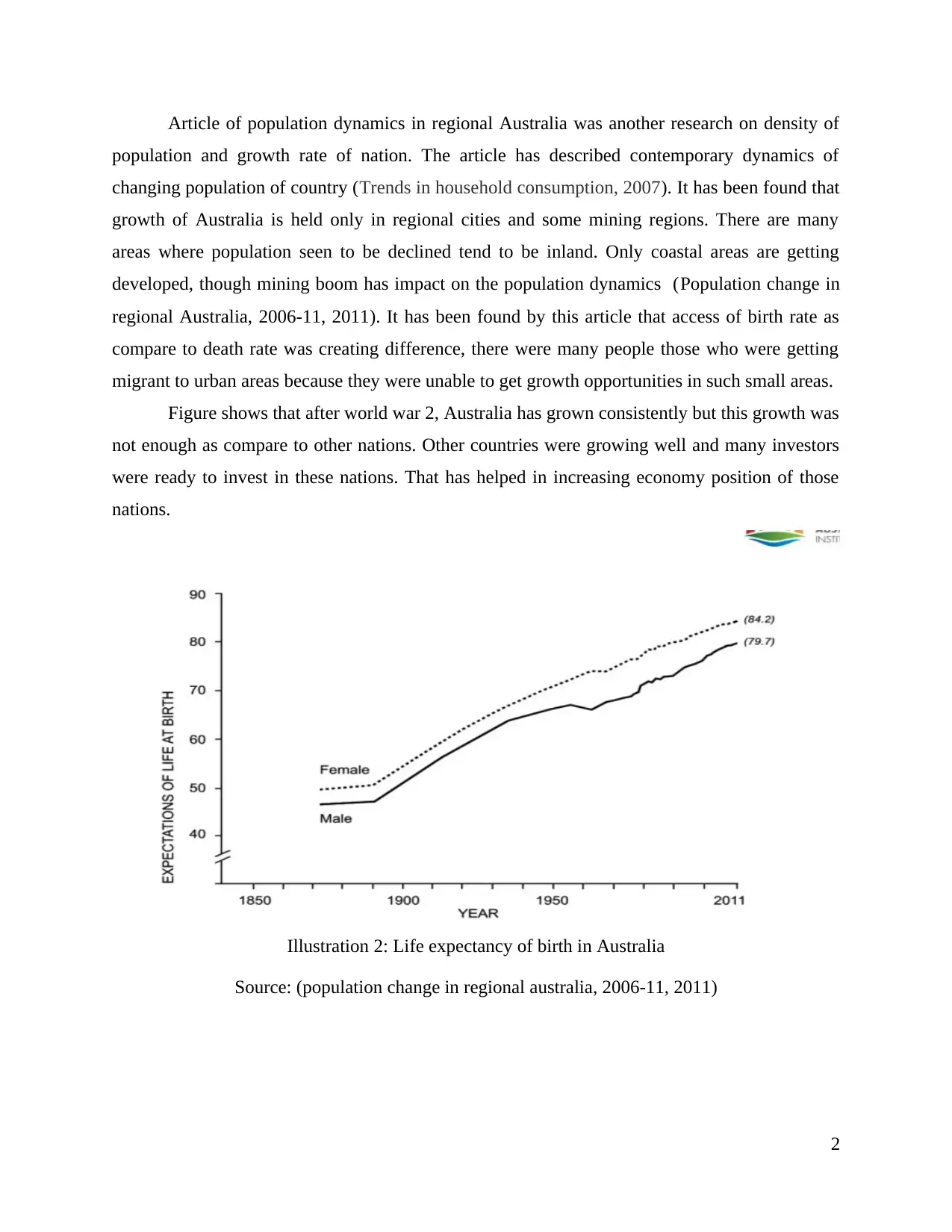
Article of population dynamics in regional Australia was another research on density of
population and growth rate of nation. The article has described contemporary dynamics of
changing population of country (Trends in household consumption, 2007). It has been found that
growth of Australia is held only in regional cities and some mining regions. There are many
areas where population seen to be declined tend to be inland. Only coastal areas are getting
developed, though mining boom has impact on the population dynamics (Population change in
regional Australia, 2006-11, 2011). It has been found by this article that access of birth rate as
compare to death rate was creating difference, there were many people those who were getting
migrant to urban areas because they were unable to get growth opportunities in such small areas.
Figure shows that after world war 2, Australia has grown consistently but this growth was
not enough as compare to other nations. Other countries were growing well and many investors
were ready to invest in these nations. That has helped in increasing economy position of those
nations.
Illustration 2: Life expectancy of birth in Australia
Source: (population change in regional australia, 2006-11, 2011)
2
population and growth rate of nation. The article has described contemporary dynamics of
changing population of country (Trends in household consumption, 2007). It has been found that
growth of Australia is held only in regional cities and some mining regions. There are many
areas where population seen to be declined tend to be inland. Only coastal areas are getting
developed, though mining boom has impact on the population dynamics (Population change in
regional Australia, 2006-11, 2011). It has been found by this article that access of birth rate as
compare to death rate was creating difference, there were many people those who were getting
migrant to urban areas because they were unable to get growth opportunities in such small areas.
Figure shows that after world war 2, Australia has grown consistently but this growth was
not enough as compare to other nations. Other countries were growing well and many investors
were ready to invest in these nations. That has helped in increasing economy position of those
nations.
Illustration 2: Life expectancy of birth in Australia
Source: (population change in regional australia, 2006-11, 2011)
2
Paraphrase This Document
Need a fresh take? Get an instant paraphrase of this document with our AI Paraphraser
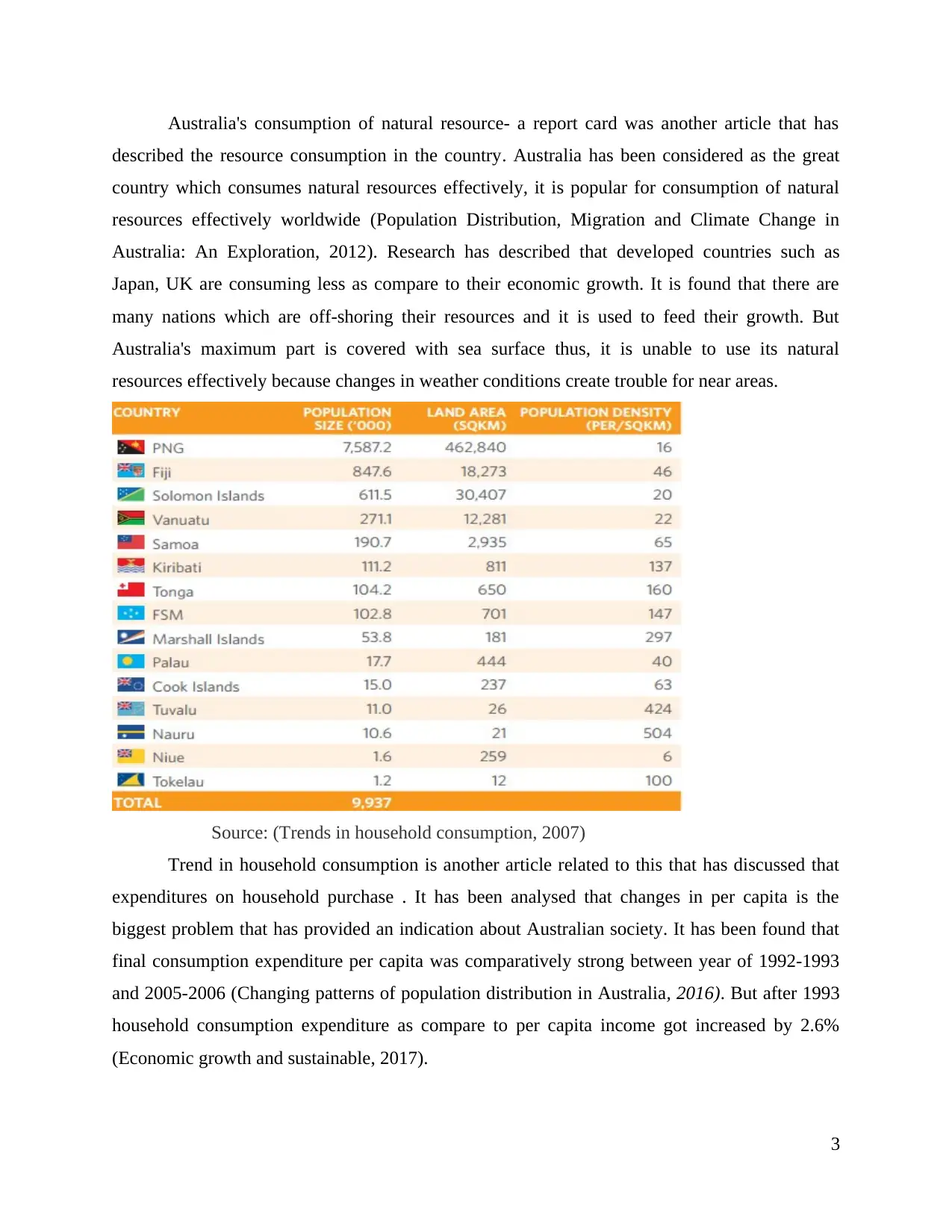
Australia's consumption of natural resource- a report card was another article that has
described the resource consumption in the country. Australia has been considered as the great
country which consumes natural resources effectively, it is popular for consumption of natural
resources effectively worldwide (Population Distribution, Migration and Climate Change in
Australia: An Exploration, 2012). Research has described that developed countries such as
Japan, UK are consuming less as compare to their economic growth. It is found that there are
many nations which are off-shoring their resources and it is used to feed their growth. But
Australia's maximum part is covered with sea surface thus, it is unable to use its natural
resources effectively because changes in weather conditions create trouble for near areas.
Source: (Trends in household consumption, 2007)
Trend in household consumption is another article related to this that has discussed that
expenditures on household purchase . It has been analysed that changes in per capita is the
biggest problem that has provided an indication about Australian society. It has been found that
final consumption expenditure per capita was comparatively strong between year of 1992-1993
and 2005-2006 (Changing patterns of population distribution in Australia, 2016). But after 1993
household consumption expenditure as compare to per capita income got increased by 2.6%
(Economic growth and sustainable, 2017).
3
described the resource consumption in the country. Australia has been considered as the great
country which consumes natural resources effectively, it is popular for consumption of natural
resources effectively worldwide (Population Distribution, Migration and Climate Change in
Australia: An Exploration, 2012). Research has described that developed countries such as
Japan, UK are consuming less as compare to their economic growth. It is found that there are
many nations which are off-shoring their resources and it is used to feed their growth. But
Australia's maximum part is covered with sea surface thus, it is unable to use its natural
resources effectively because changes in weather conditions create trouble for near areas.
Source: (Trends in household consumption, 2007)
Trend in household consumption is another article related to this that has discussed that
expenditures on household purchase . It has been analysed that changes in per capita is the
biggest problem that has provided an indication about Australian society. It has been found that
final consumption expenditure per capita was comparatively strong between year of 1992-1993
and 2005-2006 (Changing patterns of population distribution in Australia, 2016). But after 1993
household consumption expenditure as compare to per capita income got increased by 2.6%
(Economic growth and sustainable, 2017).
3
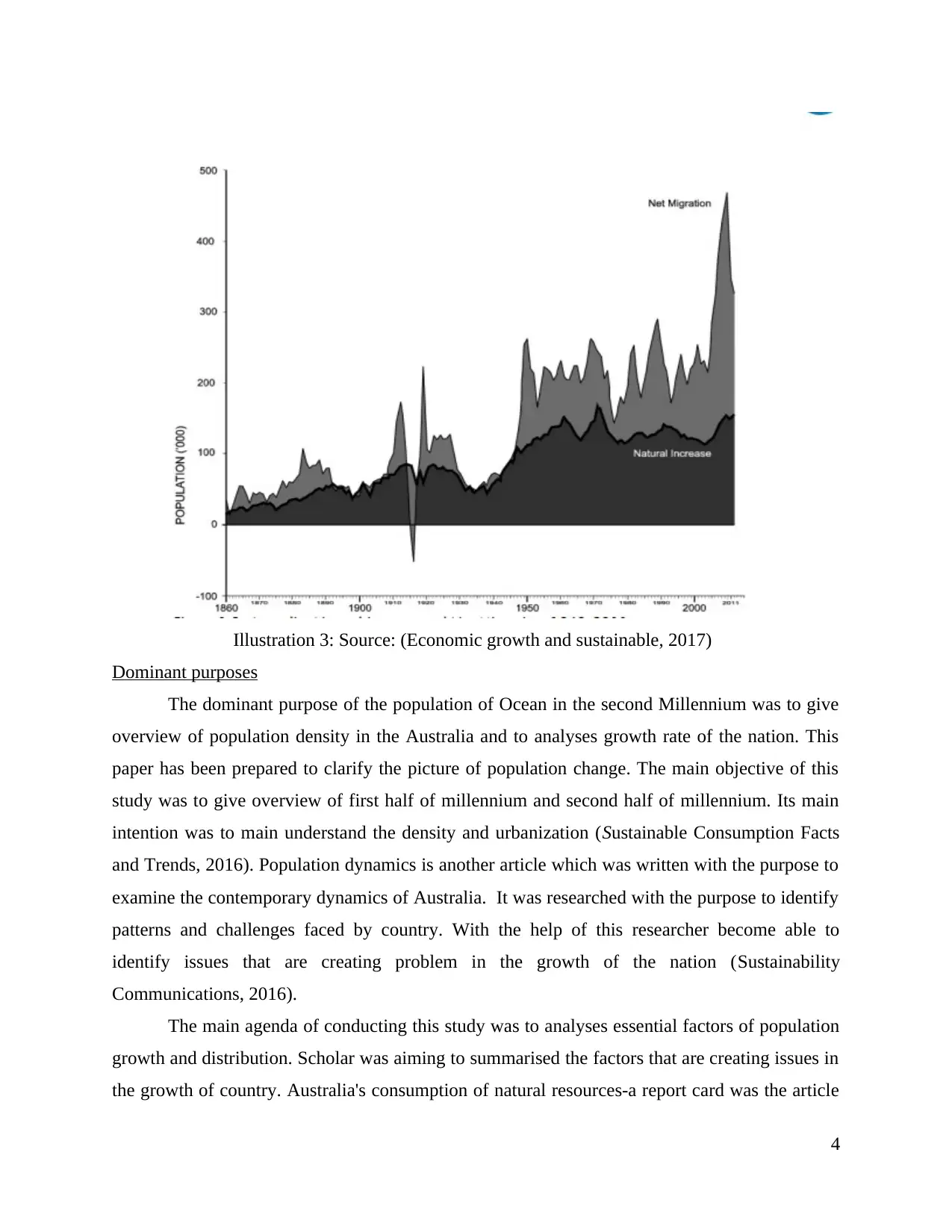
Illustration 3: Source: (Economic growth and sustainable, 2017)
Dominant purposes
The dominant purpose of the population of Ocean in the second Millennium was to give
overview of population density in the Australia and to analyses growth rate of the nation. This
paper has been prepared to clarify the picture of population change. The main objective of this
study was to give overview of first half of millennium and second half of millennium. Its main
intention was to main understand the density and urbanization (Sustainable Consumption Facts
and Trends, 2016). Population dynamics is another article which was written with the purpose to
examine the contemporary dynamics of Australia. It was researched with the purpose to identify
patterns and challenges faced by country. With the help of this researcher become able to
identify issues that are creating problem in the growth of the nation (Sustainability
Communications, 2016).
The main agenda of conducting this study was to analyses essential factors of population
growth and distribution. Scholar was aiming to summarised the factors that are creating issues in
the growth of country. Australia's consumption of natural resources-a report card was the article
4
Dominant purposes
The dominant purpose of the population of Ocean in the second Millennium was to give
overview of population density in the Australia and to analyses growth rate of the nation. This
paper has been prepared to clarify the picture of population change. The main objective of this
study was to give overview of first half of millennium and second half of millennium. Its main
intention was to main understand the density and urbanization (Sustainable Consumption Facts
and Trends, 2016). Population dynamics is another article which was written with the purpose to
examine the contemporary dynamics of Australia. It was researched with the purpose to identify
patterns and challenges faced by country. With the help of this researcher become able to
identify issues that are creating problem in the growth of the nation (Sustainability
Communications, 2016).
The main agenda of conducting this study was to analyses essential factors of population
growth and distribution. Scholar was aiming to summarised the factors that are creating issues in
the growth of country. Australia's consumption of natural resources-a report card was the article
4
⊘ This is a preview!⊘
Do you want full access?
Subscribe today to unlock all pages.

Trusted by 1+ million students worldwide
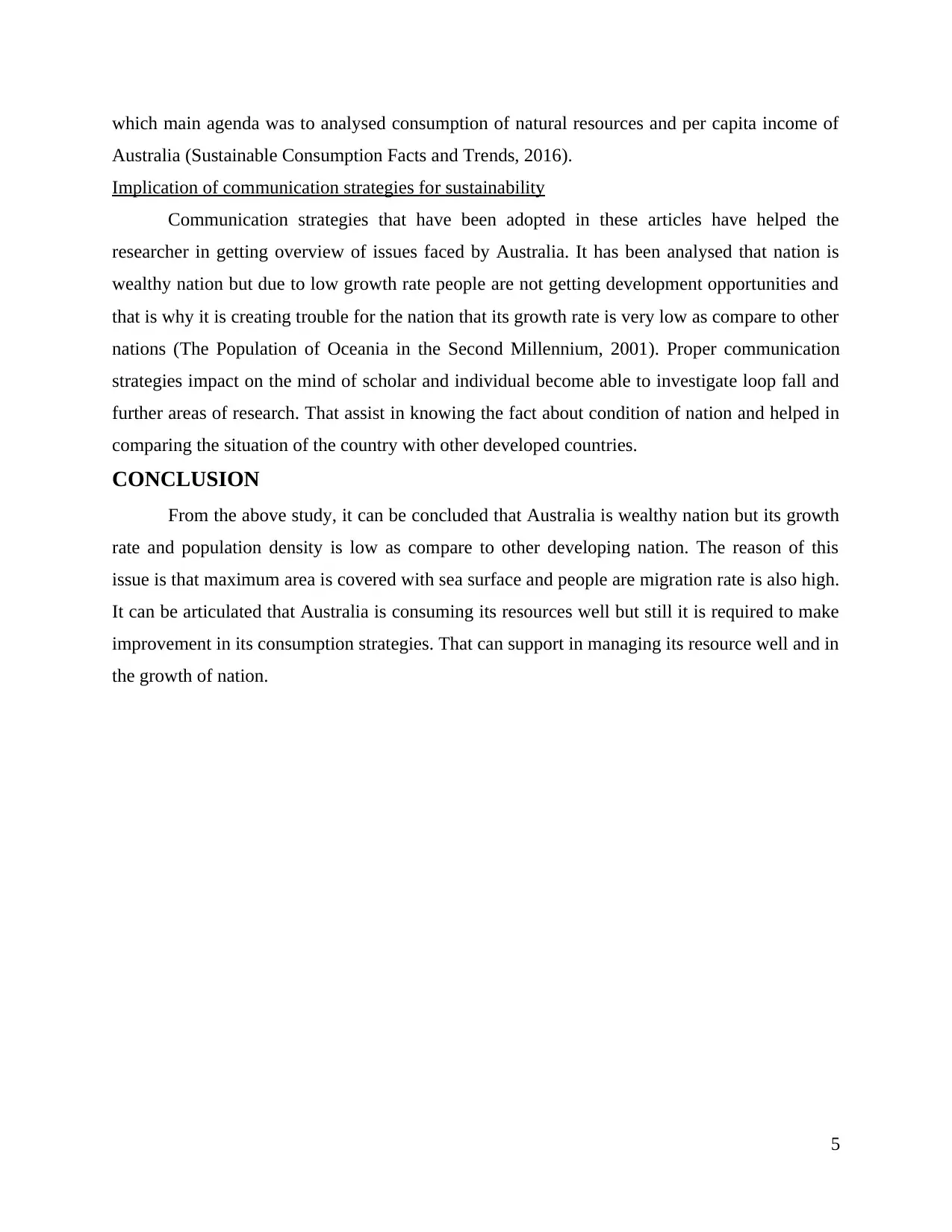
which main agenda was to analysed consumption of natural resources and per capita income of
Australia (Sustainable Consumption Facts and Trends, 2016).
Implication of communication strategies for sustainability
Communication strategies that have been adopted in these articles have helped the
researcher in getting overview of issues faced by Australia. It has been analysed that nation is
wealthy nation but due to low growth rate people are not getting development opportunities and
that is why it is creating trouble for the nation that its growth rate is very low as compare to other
nations (The Population of Oceania in the Second Millennium, 2001). Proper communication
strategies impact on the mind of scholar and individual become able to investigate loop fall and
further areas of research. That assist in knowing the fact about condition of nation and helped in
comparing the situation of the country with other developed countries.
CONCLUSION
From the above study, it can be concluded that Australia is wealthy nation but its growth
rate and population density is low as compare to other developing nation. The reason of this
issue is that maximum area is covered with sea surface and people are migration rate is also high.
It can be articulated that Australia is consuming its resources well but still it is required to make
improvement in its consumption strategies. That can support in managing its resource well and in
the growth of nation.
5
Australia (Sustainable Consumption Facts and Trends, 2016).
Implication of communication strategies for sustainability
Communication strategies that have been adopted in these articles have helped the
researcher in getting overview of issues faced by Australia. It has been analysed that nation is
wealthy nation but due to low growth rate people are not getting development opportunities and
that is why it is creating trouble for the nation that its growth rate is very low as compare to other
nations (The Population of Oceania in the Second Millennium, 2001). Proper communication
strategies impact on the mind of scholar and individual become able to investigate loop fall and
further areas of research. That assist in knowing the fact about condition of nation and helped in
comparing the situation of the country with other developed countries.
CONCLUSION
From the above study, it can be concluded that Australia is wealthy nation but its growth
rate and population density is low as compare to other developing nation. The reason of this
issue is that maximum area is covered with sea surface and people are migration rate is also high.
It can be articulated that Australia is consuming its resources well but still it is required to make
improvement in its consumption strategies. That can support in managing its resource well and in
the growth of nation.
5
Paraphrase This Document
Need a fresh take? Get an instant paraphrase of this document with our AI Paraphraser
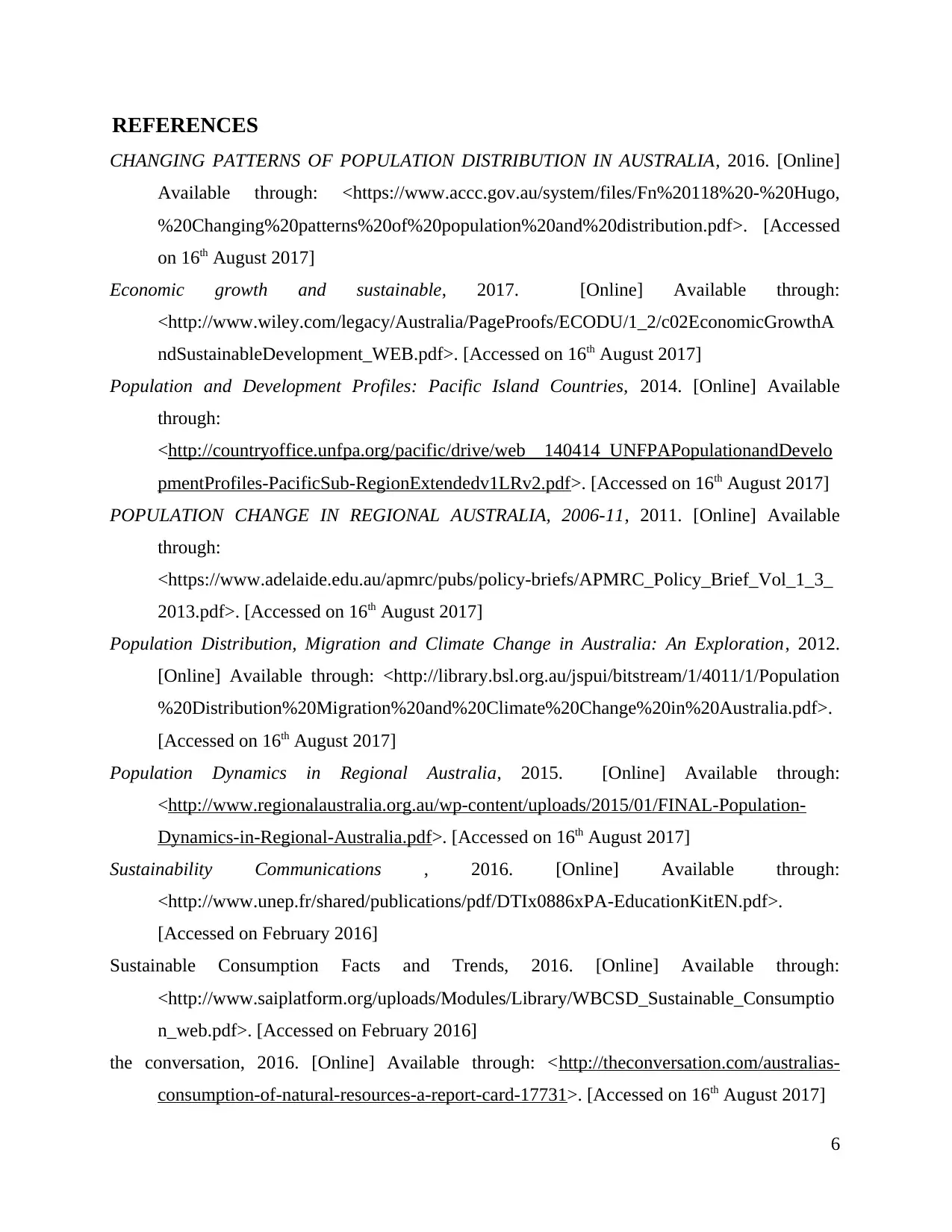
REFERENCES
CHANGING PATTERNS OF POPULATION DISTRIBUTION IN AUSTRALIA, 2016. [Online]
Available through: <https://www.accc.gov.au/system/files/Fn%20118%20-%20Hugo,
%20Changing%20patterns%20of%20population%20and%20distribution.pdf>. [Accessed
on 16th August 2017]
Economic growth and sustainable, 2017. [Online] Available through:
<http://www.wiley.com/legacy/Australia/PageProofs/ECODU/1_2/c02EconomicGrowthA
ndSustainableDevelopment_WEB.pdf>. [Accessed on 16th August 2017]
Population and Development Profiles: Pacific Island Countries, 2014. [Online] Available
through:
<http://countryoffice.unfpa.org/pacific/drive/web__140414_UNFPAPopulationandDevelo
pmentProfiles-PacificSub-RegionExtendedv1LRv2.pdf>. [Accessed on 16th August 2017]
POPULATION CHANGE IN REGIONAL AUSTRALIA, 2006-11, 2011. [Online] Available
through:
<https://www.adelaide.edu.au/apmrc/pubs/policy-briefs/APMRC_Policy_Brief_Vol_1_3_
2013.pdf>. [Accessed on 16th August 2017]
Population Distribution, Migration and Climate Change in Australia: An Exploration, 2012.
[Online] Available through: <http://library.bsl.org.au/jspui/bitstream/1/4011/1/Population
%20Distribution%20Migration%20and%20Climate%20Change%20in%20Australia.pdf>.
[Accessed on 16th August 2017]
Population Dynamics in Regional Australia, 2015. [Online] Available through:
<http://www.regionalaustralia.org.au/wp-content/uploads/2015/01/FINAL-Population-
Dynamics-in-Regional-Australia.pdf>. [Accessed on 16th August 2017]
Sustainability Communications , 2016. [Online] Available through:
<http://www.unep.fr/shared/publications/pdf/DTIx0886xPA-EducationKitEN.pdf>.
[Accessed on February 2016]
Sustainable Consumption Facts and Trends, 2016. [Online] Available through:
<http://www.saiplatform.org/uploads/Modules/Library/WBCSD_Sustainable_Consumptio
n_web.pdf>. [Accessed on February 2016]
the conversation, 2016. [Online] Available through: <http://theconversation.com/australias-
consumption-of-natural-resources-a-report-card-17731>. [Accessed on 16th August 2017]
6
CHANGING PATTERNS OF POPULATION DISTRIBUTION IN AUSTRALIA, 2016. [Online]
Available through: <https://www.accc.gov.au/system/files/Fn%20118%20-%20Hugo,
%20Changing%20patterns%20of%20population%20and%20distribution.pdf>. [Accessed
on 16th August 2017]
Economic growth and sustainable, 2017. [Online] Available through:
<http://www.wiley.com/legacy/Australia/PageProofs/ECODU/1_2/c02EconomicGrowthA
ndSustainableDevelopment_WEB.pdf>. [Accessed on 16th August 2017]
Population and Development Profiles: Pacific Island Countries, 2014. [Online] Available
through:
<http://countryoffice.unfpa.org/pacific/drive/web__140414_UNFPAPopulationandDevelo
pmentProfiles-PacificSub-RegionExtendedv1LRv2.pdf>. [Accessed on 16th August 2017]
POPULATION CHANGE IN REGIONAL AUSTRALIA, 2006-11, 2011. [Online] Available
through:
<https://www.adelaide.edu.au/apmrc/pubs/policy-briefs/APMRC_Policy_Brief_Vol_1_3_
2013.pdf>. [Accessed on 16th August 2017]
Population Distribution, Migration and Climate Change in Australia: An Exploration, 2012.
[Online] Available through: <http://library.bsl.org.au/jspui/bitstream/1/4011/1/Population
%20Distribution%20Migration%20and%20Climate%20Change%20in%20Australia.pdf>.
[Accessed on 16th August 2017]
Population Dynamics in Regional Australia, 2015. [Online] Available through:
<http://www.regionalaustralia.org.au/wp-content/uploads/2015/01/FINAL-Population-
Dynamics-in-Regional-Australia.pdf>. [Accessed on 16th August 2017]
Sustainability Communications , 2016. [Online] Available through:
<http://www.unep.fr/shared/publications/pdf/DTIx0886xPA-EducationKitEN.pdf>.
[Accessed on February 2016]
Sustainable Consumption Facts and Trends, 2016. [Online] Available through:
<http://www.saiplatform.org/uploads/Modules/Library/WBCSD_Sustainable_Consumptio
n_web.pdf>. [Accessed on February 2016]
the conversation, 2016. [Online] Available through: <http://theconversation.com/australias-
consumption-of-natural-resources-a-report-card-17731>. [Accessed on 16th August 2017]
6
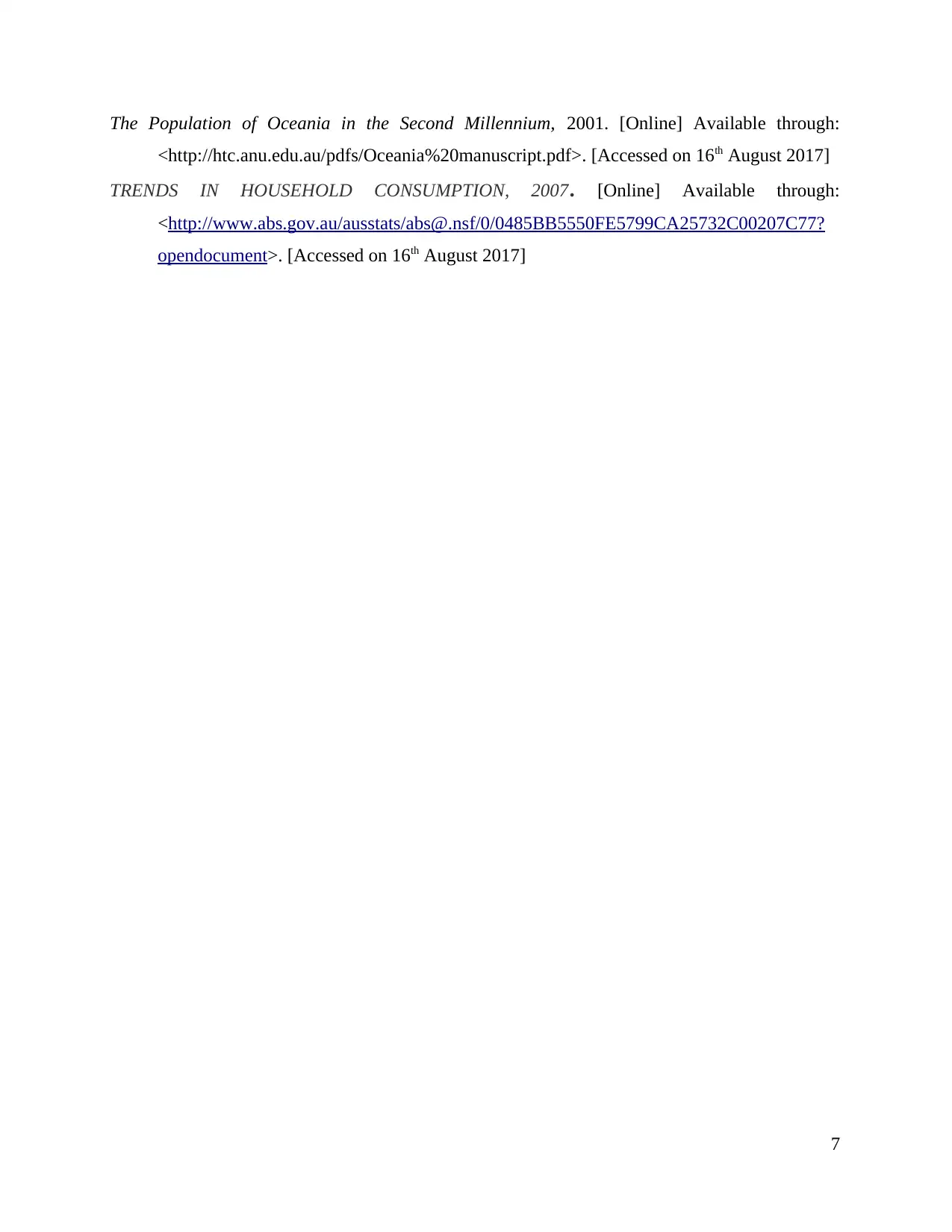
The Population of Oceania in the Second Millennium, 2001. [Online] Available through:
<http://htc.anu.edu.au/pdfs/Oceania%20manuscript.pdf>. [Accessed on 16th August 2017]
TRENDS IN HOUSEHOLD CONSUMPTION, 2007. [Online] Available through:
<http://www.abs.gov.au/ausstats/abs@.nsf/0/0485BB5550FE5799CA25732C00207C77?
opendocument>. [Accessed on 16th August 2017]
7
<http://htc.anu.edu.au/pdfs/Oceania%20manuscript.pdf>. [Accessed on 16th August 2017]
TRENDS IN HOUSEHOLD CONSUMPTION, 2007. [Online] Available through:
<http://www.abs.gov.au/ausstats/abs@.nsf/0/0485BB5550FE5799CA25732C00207C77?
opendocument>. [Accessed on 16th August 2017]
7
⊘ This is a preview!⊘
Do you want full access?
Subscribe today to unlock all pages.

Trusted by 1+ million students worldwide
1 out of 9
Related Documents
Your All-in-One AI-Powered Toolkit for Academic Success.
+13062052269
info@desklib.com
Available 24*7 on WhatsApp / Email
![[object Object]](/_next/static/media/star-bottom.7253800d.svg)
Unlock your academic potential
Copyright © 2020–2025 A2Z Services. All Rights Reserved. Developed and managed by ZUCOL.





